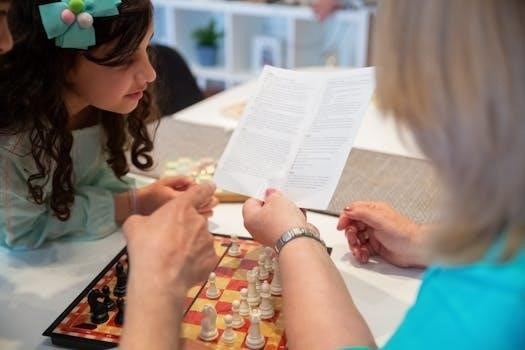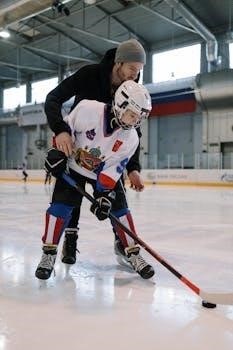pit game instructions
Objective of the Game
The goal in Pit is to dominate the market by collecting all nine cards of a single commodity type, such as wheat or rye․ Players attempt to “corner” a market for points to win the game․
Cornering the Market
To achieve victory in Pit, a player must successfully corner the market for one of the available commodities․ This involves trading cards with other players to gather a complete set of nine identical commodity cards․ When a player manages to acquire all nine cards of a single commodity type, they have effectively cornered that specific market․ This accomplishment allows them to claim the points associated with that commodity and bring them closer to victory․ The first player to corner a market rings the bell and scores points․
Number of Players
Pit is designed to accommodate a group of 3 to 8 players; This range allows for a dynamic and engaging trading experience, making it ideal for small and medium-sized gatherings․
3 to 8 Players
The game Pit is designed to be enjoyed by a group ranging from 3 to 8 players, ensuring flexibility for different group sizes․ This player range allows for a lively and competitive atmosphere as players engage in simultaneous trading․ The game scales well with the number of participants, adapting the intensity of trading to ensure an engaging experience․ With this range, Pit is a versatile option for family nights, casual get-togethers, and larger gatherings alike, providing chaotic fun for all involved․
Materials
To play Pit, you’ll need a deck of 74 playing cards representing various commodities, a bell to signal the end of trading rounds, and the game instructions for setup․
Playing Cards, Bell, Instructions
The game utilizes a specialized deck of 74 playing cards, divided into sets representing different commodities like wheat, corn, and oats․ Each set contains nine cards․ A silver bell is essential for signaling the start and end of frantic trading rounds․ Finally, a set of game instructions is necessary to understand the rules and scoring, ensuring a smooth and enjoyable gameplay experience for all participants during their market domination attempts․ It details the card values and the setup process as well․
Game Type
Pit is classified as a party card game, designed for lively interaction and fast-paced fun․ The game’s nature encourages simultaneous play and loud trading amongst players․
Party Card Game
The Pit card game is a perfect choice for a party atmosphere, designed to be engaging and entertaining for a group of players․ Its fast-paced nature and simultaneous trading create a lively and often chaotic environment that is well-suited to social gatherings․ The game encourages interaction and shouting, making it a fun and exciting experience for players of all ages․ The simple rules also make it easy for newcomers to quickly join in on the fun without complicated instructions, ensuring a great experience for all․

Target Audience
Pit is designed to be enjoyed by a wide range of players, making it suitable for ages 7 and up․ Its easy-to-learn rules ensure that both children and adults can have fun․
Ages 7 and Up
The game’s accessibility and fast-paced nature make it perfect for younger players, while still offering enough strategic depth to engage adults․ The simple concept of collecting matching sets combined with the exciting element of simultaneous trading ensures that players of varying ages can enjoy playing together․ The recommended age of 7 and up is not just a suggestion, but a sweet spot where the game’s excitement and simple mechanics can be fully appreciated, making it a fantastic choice for family gatherings and parties alike․ The chaotic fun of Pit transcends age barriers․
Overview
Pit is a lively card game simulating the frantic energy of commodity trading․ Players simultaneously trade cards, yelling offers, to collect a set of nine matching commodity cards to win․
Fast-Paced Trading Simulation
Pit immerses players in a chaotic world of commodity trading, where quick decisions and fast reflexes are key․ This fast-paced simulation encourages players to actively engage in simultaneous trades with each other․ The game is a whirlwind of yelling, bargaining, and strategic maneuvering as everyone attempts to corner the market on their desired commodities․ Players must be alert and ready to adapt to the changing market, mirroring the pressures of real-world trading floors, making it a unique and energetic experience․ The constant need to trade and react to other players’ moves makes each game a dynamic and engaging challenge․

Card Distribution
The number of cards dealt to each player varies․ In games with 7-10 players, each player gets 8 cards; for 11-12 players, each player receives 7 cards․
Varies by Player Count
The initial card distribution in Pit depends on how many players are participating․ In games with a smaller group of 3-6 players, each player is typically dealt nine cards․ When the number of players increases, the card distribution is modified to ensure a balanced game․ For example, with 7 to 10 players, each player receives eight cards, and in games with 11 or 12 participants, each player is dealt seven cards, adjusting the game to accommodate the larger player count and maintain the fast-paced nature of the trading․

Gameplay
The gameplay involves simultaneous trading where players shout out the number of cards they wish to exchange with others․ The goal is to quickly collect sets of matching commodities․
Simultaneous Trading and Yelling
In Pit, trading is a chaotic free-for-all․ Players simultaneously yell out how many cards they wish to trade, such as “One,” “Two,” or “Three,” and then quickly exchange cards with other players who are also yelling out the same number of cards․ This creates a fast-paced, loud, and often confusing environment․ Players must be quick and assertive to get the cards they need to complete their set․ The game is a test of speed, and observation, and the ability to trade effectively amidst the chaos․

Winning Condition
The first player to successfully collect all nine cards of the same commodity, forming a complete set, wins the round by ringing the bell and declaring victory․
Collecting a Full Set of Commodity Cards
To win a round of Pit, players must focus on acquiring all nine cards of a single commodity․ This involves quick and strategic trading with other participants․ The game is a race against the clock and other players to be the first to assemble a complete set of one commodity, such as corn, wheat, or oats․ Once a player has all nine cards, they ring the bell to signal their success, thereby winning the round and scoring points for that commodity․ Players must be observant and proactive in trading to be the first to collect a complete commodity set․
Bull and Bear Cards
For a more advanced game, Pit includes optional Bull and Bear cards․ The Bull card adds points, while the Bear card subtracts them from the final score․
Optional Addition for Advanced Play
The Bull and Bear cards introduce a dynamic element, allowing for strategic risk-taking and potential point swings․ The Bull card, when collected, grants a bonus to the player, while the Bear card can impose a penalty, often resulting in a loss of points․ These cards are added to the deck and dealt randomly, and can change the course of the game as players try to avoid the negative effects of the Bear while simultaneously trying to acquire the positive benefits of the Bull․ This creates a more chaotic and unpredictable trading scenario, intensifying the experience․
Scoring
Players earn points by successfully cornering a commodity․ Each commodity has a point value, with wheat usually worth the most․ The game ends when a player reaches a target score․
Points Awarded for Cornering Commodities
Successfully collecting all nine cards of a specific commodity is how players score in Pit․ Each commodity has a different point value assigned to it․ For instance, cornering wheat usually yields 100 points, while corn might be worth 75 points, and oats a lower 60 points․ The points vary for different commodities․ The game continues until a player reaches 500 points․ The specific value of each commodity is typically indicated directly on the cards, and those scores are tallied to determine the winner․ Therefore, it’s important to know which cards are of higher value․